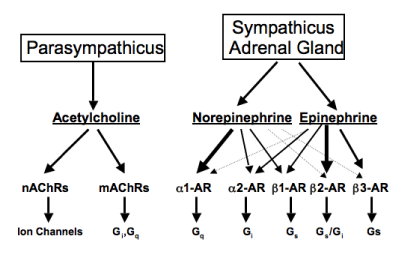
 |
| Figure 1: The autonomic nervous system with its two branches, the parasympathicus and the sympathicus, regulates cell and organ functions that are not under voluntary control. Parasympathetic nerves release the neurotransmitter acetylcholine that is an agonist for the ion channel family of nicotinic acetylcholine receptors (nAChRs) and for muscarinic receptors (mAChRs) that are coupled to the inhibitory G-protein Gi or to Gq. Sympathetic nerves and the adrenal medulla release the stress neurotransmitters norepinephrine and epinephrine that are agonists for the G-protein coupled receptor families of α-and β-adrenergic receptors (ARs). Norepinephrine binds preferentially to the Gq-coupled α1-AR while having little activity at the β2-AR. Epinephrine binds preferentially o β2-ARs thus activating both, stimulatory Gs-and inhibitory Gi-proteins. Both stress neurotransmitters bind with similar affinities to the Gi-coupled α2-AR and to the Gs-coupled β1-AR. |